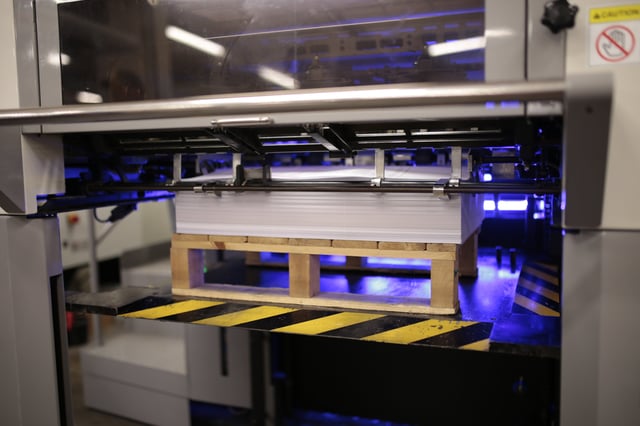As technology improves within the printing industry more and more ways of commercial printing are being introduced; therefore there are a lot of options to choose from when it comes to your marketing material. Litho and digital printing are the two most common types of print. Let’s answer, "what is litho printing vs digital printing?"
The Basic Difference
Litho and digital printing are very different as litho printing uses wet ink and printing plates; whereas only some digital printers use ink and others use toner on a press, which is similar to how an office printer works.
Both printing techniques have pros and cons but are very different to one another, so choosing between the two can be difficult.
If you aren't sure on any of the terminology used in this post, we suggest taking a look at this blog: Bleedin' Heck and What The Crop: A Glossary Of 40+ Printing Terms.
Then we will look at how litho and digital print differ in terms of:
- Print Quality
- Speed
- Cost
- Types Of Materials
- Personalisation
- The Merits Of Litho vs Digital Printing
Print Quality
Print quality is extremely important, especially if you use printed products for marketing. When it comes to comparing both printing techniques, traditionally litho printing produced products of a higher quality than simple digital; however, with new technology, it's tough for the average person to see the difference in quality between both printing techniques.
Litho printing is the better choice of printing technique if your design requires a lot of large blocks of solid colour, as the colour will come out a lot smoother compared to digital printing. Especially when using a super-sophisticated drying technique like LED UV, of which B&B were one of the first in the country to install.
Between both printing techniques, the finish of the print is also very different; when it comes to litho printing the ink used soaks into the paper, whereas with digital printing the ink sits on the surface of the paper. This means that the same image could look different if printed by litho and digital printing.
When it comes to printing onto different types of paper such as textured and coloured, litho printing is the better option; however, there isn’t much difference between the two when it comes to printing on glossy, silk, or uncoated paper, as both techniques offer a good coverage and a high-quality print.

A behind-the-scenes peek into our litho print room. A place we're very proud to say has a couple of LED UV printers, amongst the best in the UK and we were one of the first to adopt this technique.
Speed
Digital printing has a very quick set up time, as the design is uploaded onto a computer and then you press print and the print begins - just like the everyday office printer. Quick and easy. Once the print has begun, it can print off around 4,800 sheets per hour.
When it comes to litho printing, the setup takes a lot longer as the design has to be made on printing plates; however when this process has been done, litho printing produces more prints - at 18,000 per hour.
When deciding which option is best, you have to consider the quantity you want in the specified time. If you want a smaller amount printed quickly, then digital printing is the best option; however, if you are looking to produce large quantities of print, then litho printing is the better option.
Cost
Digital printing doesn’t take any time to setup so there is no initial setup charge; you don’t have to pay a penny until the printing process actually begins. You only pay for the paper used and what is known as the “click charge”, which is each sheet that goes through the digital printing machine.
Litho printing is different as there is a setup process before the printing actually begins, so there is a setup charge. This means there is an upfront cost when it comes to litho printing.
You also, like the digital printing process, have to pay for the paper and the ink used. However, after the initial setup cost, litho printing is cheaper than digital printing, because once the printing plates have been created, you can use them as often as you want. Litho printing is also faster than digital printing during the print process.
To produce a small amount of material at a low price, digital printing is the better option; however, litho printing works out cheaper when it comes to producing a large amount of print.
Types Of Materials
Leaflets, brochures, and other marketing materials can be printed on a range of materials such as glossy, silk, uncoated, textured and coloured card or paper. We call this 'stock' in the trade.
Between both litho and digital printing, litho printing produces better quality work when printing on all materials; whereas digital printing does not print as well on rough or heavily textured materials.
When printing on paper, choosing between litho and digital printing won’t affect the quality as they will produce very similar outcomes; there isn’t much difference between the two types of print on materials such as paper.

Large scale, vibrant printing on heavy duty stock. This can done directly onto a stock heavy enough for wall hanging.
Personalisation
Personalised marketing products can make a big difference such as including a person’s name, and, with digital printing, personalising prints is easy and quickly done as there is no extra setup procedure.
When it comes to litho printing, as the design has to be created onto the printing plates, having personalised prints will be costly as there will have to be a different plate for each print. Therefore, when it comes to personalising your prints, digital printing is the best option as it is easily done and doesn’t cost anything at all.
Litho Printing Vs Digital Printing
There is no specific printing technique that is better than the other, as it all depends on what you are printing, how many prints you need, what level of quality you need, the material you’ll be printing on, how quickly you need the prints, if you need personalisation, budget, and so on.
Digital printing is cost effective when it comes to printing a few prints whilst litho printing, even though you have to pay for the setup, works out cheaper if you are printing large quantities of prints.
Litho printing is the better quality method when using textured paper and when the design requires a large colour block coverage. However, when you are printing on a more typical stock, the quality between the two printers isn’t noticeable.
When it comes to choosing between digital and litho printing, you need to take these factors into consideration such as the quantity of the print, the material you want the print to be printed on, your budget and the design you are wanting to be printed as both printers have their pros and cons and certain aspects of the factors you need to consider.
Need More Help Deciding?
If you are still wondering about print options and what would be the best printer to use, check out our printing guide, where we cover all the printers available and what they work well with.
